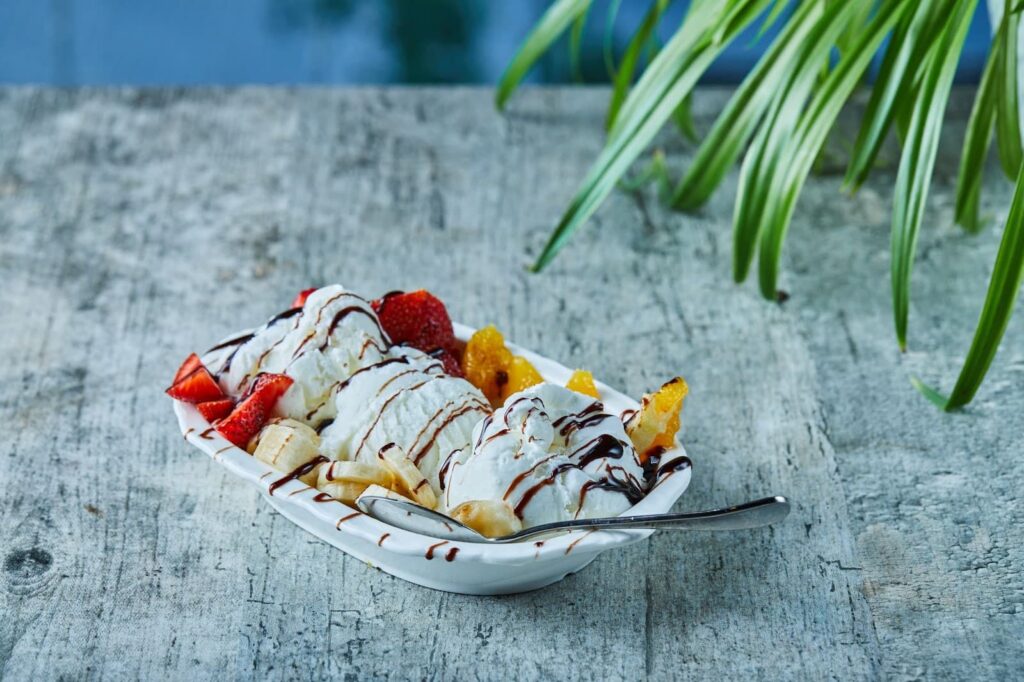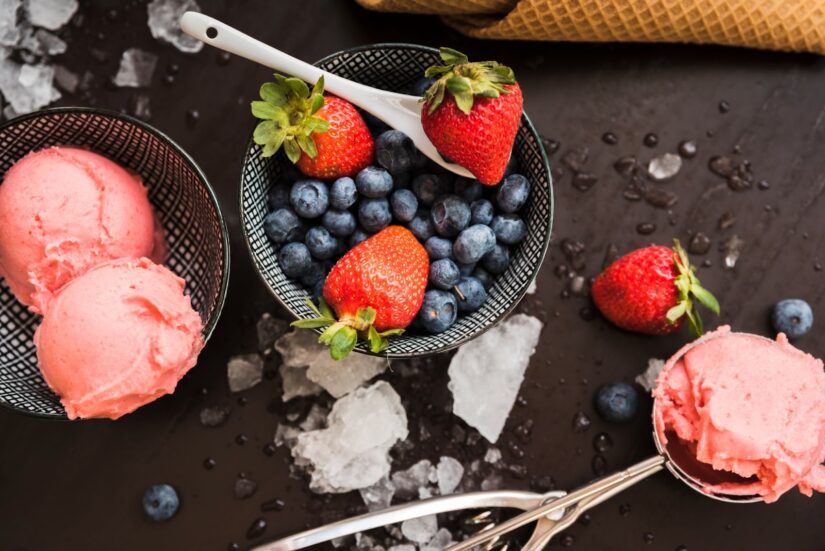Indulge in Delectable Custard-Flavored Dairy-Free Ice Cream
Indulging in a scoop of ice cream has always been a beloved pleasure, but for those who are lactose intolerant, vegan, or simply seeking a healthier alternative, the world of frozen desserts has evolved in a delightful way. Enter dairy-free ice cream – a delectable revelation that proves you don’t need dairy to enjoy the silky smooth, velvety goodness of ice cream. In this article, we’ll take you on a journey through the tantalizing universe of dairy-free ice cream, exploring its diverse flavors, surprising ingredients, and how it’s changing the way we savor frozen treats. Whether you’re a dedicated vegan, lactose-sensitive, or simply curious, get ready to savor a scoop of sheer indulgence without a hint of guilt.
Redefining Dairy-Free Alternatives: Finding the Balance Between Taste and Nutrition
In the world of dietary choices, few are as polarizing as the decision to go dairy-free. Some embark on this journey due to ethical concerns, while others, like my son, are forced by allergies to bid farewell to traditional dairy products. During my own dairy-free stint, which lasted for approximately three months during my son’s first year, I formed a rather passionate stance on the matter: some things should remain dairy or not exist at all.
Here, we’ll explore the intriguing realm of dairy-free alternatives, shedding light on products that may not always live up to the dairy originals, and why. However, it’s essential to remember that these alternatives can still serve as valuable options for individuals with dietary restrictions or preferences.
Soy Cheese: A Questionable Substitute
- Taste Analysis: In moments of dairy cravings, I couldn’t bring myself to embrace soy cheese. It falls far short of replicating the authentic taste and texture of traditional dairy cheese. The disparity becomes evident when you melt it on a pizza or savor it in a sandwich;
- Nutritional Insights: While soy cheese may not match dairy cheese in terms of taste, it offers certain nutritional advantages. It’s typically lower in saturated fats and cholesterol, making it a heart-healthier option;
- Recommendation: If you’re seeking a dairy-free cheese alternative that closely resembles the real thing, explore cashew-based or almond-based cheese options. These alternatives often provide a more satisfying culinary experience.
Soy Yogurt: Wrestling with an Unpleasant Aftertaste
- Taste Evaluation: Soy yogurt, despite its promising dairy-free credentials, leaves a lingering chemical aftertaste that can be unsettling for many. This unusual sensation may deter some from embracing it as a satisfying yogurt alternative;
- Nutritional Value: From a nutritional standpoint, soy yogurt stands as a commendable choice. It offers a substantial dose of plant-based protein, probiotics for gut health, and is naturally lactose-free;
- Tip: For those seeking an enjoyable yogurt substitute without the aftertaste, consider almond or coconut yogurt. These options often provide a smoother and more appealing taste profile.
Rice and Soy Ice “Dreams”: A Cold Reality Check
- Taste Exploration: In moments of desperation for a frozen delight, a friend once bestowed a carton of rice-milk-based ice “dream” upon me. While I appreciated the gesture, it failed to fill the dairy-shaped void in my heart. The taste simply didn’t compare to traditional ice cream;
- Nutritional Consideration: Rice and soy-based ice creams have their merits. They’re typically lower in saturated fats and cholesterol, which is excellent for those prioritizing heart health. However, they may not offer the same creamy texture or taste that many associate with ice cream;
- Insight: For an indulgent dairy-free frozen dessert experience, explore almond-based or coconut-based ice creams. These alternatives often provide a creamier texture and a richer taste, making them a more satisfying treat.
Mastering Dairy-Free Delights
Two years have passed, and the young boy is on the brink of celebrating his fourth birthday. During this time, I’ve delved deeper into the world of non-dairy cooking, mastering the art of crafting delectable treats without the need for traditional dairy ingredients. One remarkable discovery I made about six months ago was the incredible versatility of coconut milk. This revelation has revolutionized our approach to dairy-free cuisine, opening doors to a realm of culinary possibilities we once thought were inaccessible.
Here’s what we’ve learned and embraced in these two years:
The Wonders of Coconut Milk:
Coconut milk emerged as a game-changer in our non-dairy journey. It boasts a higher fat content, but it’s the good kind of fat that remarkably mimics the consistency of its dairy counterparts.
Coconut milk has the power to transform ordinary recipes into indulgent delights without compromising texture. Its magic lies in its capacity to create creaminess, making it a top choice for dairy-free cooking.
However, a word of caution: Too much coconut milk can overwhelm with its distinct flavor. Balance is key when incorporating it into recipes, especially when subtlety is desired.
Dairy-Free Weekend Breakfast Extravaganza:
Saturday mornings have become a delightful ritual at our home, thanks to dairy-free pancakes. These pancakes are now so delicate, rich, and indiscernible from our old milk-based standby recipe.
Recommendations: Try adding a touch of vanilla extract or a pinch of cinnamon to your dairy-free pancake batter for extra flavor. Also, consider using almond or oat milk for a different twist.
Irresistible Dairy-Free Hot Cocoa:
We’ve elevated our hot cocoa game by treating the kids to dairy-free hot cocoa once or twice a week. It’s so thick and creamy that my milk-loving daughter doesn’t even realize she’s missing out on dairy.
Tips: For an extra treat, top your dairy-free hot cocoa with dairy-free whipped cream and a sprinkle of cocoa powder or cinnamon.
Dairy-Free Ice Cream Delight:
Inspired by David Lebovitz’s ice cream book, I ventured into the world of dairy-free ice cream by completely substituting traditional dairy with canned, full-fat coconut milk.
The choice of a French-style ice cream, characterized by its custard base using egg yolks, maximized the richness of the ice cream.
Result: We’ve achieved an ice cream so remarkably similar to the real deal that no excuses are needed when adding a scoop to every slice of cake.
Planning a Dairy-Free Cake-and-Ice-Cream Birthday:
As the Little Man’s fifth birthday approaches, he will finally experience a genuine cake-and-ice-cream celebration, complete with a dairy-free twist.
Although it may seem contradictory, we decided to retain the name “ice cream” for our dairy-free creation because it’s so wonderfully creamy. Labeling it a “frozen dessert” would not do justice to its texture and flavor.
Creating Dairy-Free Vanilla Ice Cream
Are you craving a creamy and luscious ice cream that’s free from dairy products? Look no further! This dairy-free vanilla ice cream recipe, adapted from David Lebovitz’s The Perfect Scoop, will satisfy your ice cream cravings while catering to your dietary preferences. Whether you’re lactose intolerant, vegan, or just looking for a new twist on a classic favorite, this recipe has got you covered. Read more about the perfect harmony of crisp carrots and fresh dill in our delightful carrot dill salad recipe. Elevate your salad game today!

Ingredients:
- 3 cups of full-fat coconut milk (from 2 cans);
- Opt for reputable brands like Thai Kitchen, Chaokoh, or 365 for the best results;
- 3/4 cup of sugar;
- A pinch (about 1/8 tsp) of table salt;
- 1 vanilla bean, split in half lengthwise;
- 5 large egg yolks;
- 3/4 tsp of pure vanilla extract.
Let’s embark on this delightful ice cream-making journey, ensuring that each step is infused with flavor and richness.
Step 1: Preparing the Coconut Milk Base
- Open both cans of coconut milk and scoop their contents into a glass bowl or a 4-cup glass measure;
- Warm the mixture in the microwave for about a minute, stirring every 30 seconds until the thick coconut cream liquefies, resulting in a smooth consistency;
- Measure out 2 cups of this coconut milk mixture and transfer it to a saucepan;
- Add the sugar and a pinch of salt to the saucepan with the coconut milk;
- Place the saucepan over low heat and gently warm the mixture until it becomes very warm to the touch, ensuring that the sugar fully dissolves.
- Scrape the aromatic seeds from the split vanilla bean into the warm mixture, and don’t forget to add the bean itself;
- Cover the saucepan, remove it from the heat source, and let it steep at room temperature for 30 minutes. This infusion will intensify the vanilla flavor, making your ice cream truly exceptional.
Step 2: Preparing the Custard Base
- Measure out another cup of coconut milk, reserving any leftover for future culinary adventures;
- Pour the cup of coconut milk into a large bowl and place a mesh strainer on top, setting it aside for later use;
- In a separate medium-sized bowl, whisk the egg yolks until they are well combined and slightly frothy;
- Slowly ladle approximately one-third of the warm, steeped coconut milk from the saucepan into the egg yolks, all while whisking continuously. This technique prevents the eggs from curdling and ensures a smooth custard base;
- Return the egg mixture to the saucepan with the remaining coconut milk mixture.
Step 3: Cooking the Custard
- Stir the combined mixture constantly over medium heat using a flat-ended wooden spoon or a silicone spatula;
- As you stir, make sure to scrape the bottom of the pan to prevent any sticking or burning;
- Continue to cook until the custard thickens and coats the back of your spatula. If you have a thermometer, aim for a temperature of 170ºF; avoid exceeding 185ºF to prevent scrambling;
- Once the custard reaches the desired consistency, pour it through the mesh strainer into the coconut milk in the large bowl;
- Add the vanilla bean back into the mixture, infusing even more vanilla goodness;
- To cool the custard quickly, stir it over an ice bath.
Step 4: Chilling and Freezing
- Refrigerate the custard for several hours or, ideally, overnight to ensure it chills completely;
- Remove the vanilla bean, which has now given its all to flavor your ice cream;
- Follow your ice cream maker’s instructions to freeze the custard and transform it into velvety dairy-free vanilla ice cream.
Tip: Dairy-Free Chocolate Chip Ice Cream
- Enhance your vanilla ice cream experience by adding dairy-free chocolate chips;
- Melt 5 oz. of dairy-free bittersweet or semi-sweet chocolate using a double-boiler;
- During the last moments of churning your ice cream, drizzle the warm chocolate into it;
- The cold ice cream will freeze the chocolate, breaking it into delightful bits throughout your creamy creation;
- Enjoy your homemade dairy-free vanilla ice cream, knowing that it’s both delicious and catered to your dietary preferences. It’s the perfect treat for all occasions, from hot summer days to cozy winter nights.
Conclusion
In conclusion, the world of dairy-free ice cream has evolved significantly over the years, offering a delicious and satisfying alternative to traditional dairy-based options. With a wide range of flavors and ingredients to choose from, consumers now have the opportunity to indulge in rich and creamy frozen treats without compromising on taste or texture. Whether you’re lactose intolerant, vegan, or simply looking to explore new culinary horizons, dairy-free ice cream has proven itself to be a delightful and inclusive option for all. As the demand for plant-based and allergy-friendly options continues to grow, we can expect to see even more innovation and diversity in the dairy-free ice cream market, providing everyone with the opportunity to savor the sweet pleasures of this frozen delight. So, go ahead and treat yourself to a scoop of dairy-free ice cream – it’s a delectable experience that’s here to stay.
